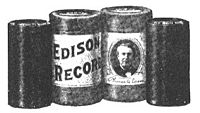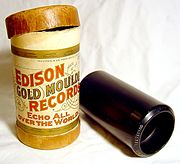
Phonograph cylinder
About this schools Wikipedia selection
SOS Children have produced a selection of wikipedia articles for schools since 2005. SOS Children has looked after children in Africa for forty years. Can you help their work in Africa?
The earliest method of recording and reproducing sound was on phonograph cylinders. Commonly known simply as "records" in their era of greatest popularity (c. 1888–1915), these cylinder shaped objects had an audio recording engraved on the outside surface which could be reproduced when the cylinder was played on a mechanical phonograph. The competing disc-shaped gramophone record system triumphed in the market place to become the dominant commercial audio medium in the 1910s, and commercial mass production of phonograph cylinders ended in 1929.
Early development of the phonograph cylinder
The phonograph was conceived by Thomas Edison on 18 July 1877 for recording telephone messages, his first test using waxed paper. In early production versions the recordings were done on the outside surface of a strip of tinfoil wrapped around a rotating metal cylinder. By the 1880s wax cylinders were mass marketed. These had sound recordings in the grooves on the outside of hollow cylinders of slightly soft wax. These cylinders could easily be removed and replaced on the mandrel of the machine which played them. Early cylinder records would commonly wear out after they were played a few dozen times. The buyer could then either bring the worn cylinders back to the dealer to be traded in as partial credit for purchase of new recordings, or have their surface shaved smooth so new recordings could be made on them. In 1890 Charles Tainter patented the use of hard carnauba wax as a replacement for the common mixture of paraffin and beeswax used on phonograph cylinders.
Early cylinder machines of the late 1880s and the 1890s were often sold with recording attachments. The ability to record as well as play back sound was an advantage to cylinder phonographs over the competition from cheaper disc record phonographs which began to be mass marketed at the end of the 1890s, as the disc system machines could be used only to play back pre-recorded sound.
In the earliest stages of phonograph manufacturing various competing incompatible types of cylinder recordings were made. A standard system was decided upon by Edison Records, Columbia Phonograph, and other companies in the late 1880s. The standard cylinders were about 4 inches (10 cm) long, 2¼ inches in diameter, and played about two minutes of music or other sound.
Commercial packaging
Cylinders were sold in cardboard tubes, with cardboard lids at each end. These containers helped protect the recordings. These containers and the shape of the cylinders (together with the "tinny" sound of early records compared to live music) prompted bandleader John Philip Sousa to deride the records as canned music. Record companies usually had a generic printed label on the outside of the cylinder package, with no indication of the identity of the individual recording inside. Early on such information would be written on the labels by hand, one at a time. Slightly later, the record number would be stamped on the top lid, then a bit later the title and artist of the recording would be printed on to labels on the lid. Shortly after the start of the 20th century, an abbreviated version of this information (together with the name of the record company) would be printed or impressed on to one edge of the cylinder itself. Previously the actual cylinders had no such visual identification. However they would have a spoken announcement of the song or performance title, recording artist, and record company recorded on to the beginning of the recording.
Small paper inserts with the recording information were placed inside the package with the cylinders. At first this was hand written or typed on each slip, but printed versions became more common once cylinders of certain songs were sold in large enough quantities to make this economically practical. Note that in the example in the image below, from Edison Records, 1902, the consumer is invited to cut out the circle with printed information. This paper circle could then be pasted either to the lid of the cylinder container, or (as this example prompts) to a spindle for this cylinder in specially built cabinets for holding cylinder records which were marketed by record companies. Only a minority of cylinder record customers purchased such cabinets, however.
Further improvements of commercial cylinders
Over the years the type of wax used in cylinders was improved and hardened so that cylinders could be played over 100 times. In 1902 Edison Records launched a line of improved hard wax cylinders marketed as "Edison Gold Moulded Records".
Hard plastic replaces wax
In 1906 the Indestructible Record Company began mass marketing cylinder records made of celluloid, an early hard plastic, that would not break if dropped and could be played thousands of times without wearing out. This hard inflexible material could not be shaved and recorded over like wax cylinders, but had the advantage of being a nearly permanent record. (Such "Indestructible" style cylinders are arguably the most durable form of sound recording produced in the entire era of analogue audio before the introduction of digital audio; they can withstand a great number more playbacks before wearing out than such later media as the vinyl record or audio tape.) This superior technology was purchased by the Columbia Phonograph Company. The Edison company then developed their own type of long lasting cylinder, consisting of a type of plastic called Amberol around a plaster core; these were called Amberol cylinders. Around the same time Edison introduced 4 minute cylinders, having twice the playing time of the old standard cylinder, achieved simply by shrinking the groove size and spacing them twice as close together in the spiral around the cylinder. Most (but not all) Amberol cylinders are of the four-minute variety. Edison phonographs for playing these improved cylinder records were called Amberolas. See also: Blue Amberol Records.
Cylinders versus discs
In the era before World War I phonograph cylinders and disc records competed with each other for public favour.
The audio fidelity of a sound groove is not inherently better if it is engraved on either a disc or a cylinder, and the competition was due to other factors.
Advantages of cylinders
The cylinder system had certain advantages. As noted, wax cylinders could be used for home recordings, and "indestructible" types could be played over and over many more times than the disc. Cylinders usually rotated at a greater speed than discs, creating a greater linear velocity of the stylus in the groove. In theory, this would provide better audio fidelity. Furthermore, since constant angular velocity translates into constant linear velocity (the radius of the spiral track is constant), cylinders were also free from inner groove problems suffered by disc recordings. Around 1900 cylinders on average were indeed of notably higher audio quality than contemporary discs, but as disc makers improved their technology by 1910 the fidelity differences between better discs and cylinders became minimal.
Cylinder phonographs generally used a worm gear to move the stylus in synchronization with the grooves of the recording, whereas most disc machines relied on the grooves to pull the stylus along. This resulted in cylinder records played a number of times having less degradation than discs, but this added mechanism made cylinder machines more expensive.
Advantages of discs
Both the disc records and the machines to play them on were cheaper to mass-produce than the products of the cylinder system. Disc records were also easier and cheaper to store in bulk, as they could be stacked, or when in paper sleeves put in rows on shelves like books.
Many cylinder phonographs used a belt to turn the mandrel; slight slippage of this belt could make the mandrel not turn evenly, thus resulting in pitch fluctuations. Disc phonographs using a direct system of gears could not really turn unevenly; the heavy metal turntable of disc machines acted as a flywheel, helping to minimize speed wobble.
In 1908 Columbia Records introduced mass production of disc records with recordings pressed on both sides, which soon became the industry standard. Patrons of disc records could now get two recordings for less than the price of one on cylinder.
Mention should also be made of the superior advertising and promotion done by the disc companies, most notably by the Victor Talking Machine Company in the United States and the Gramophone Company/ HMV in the Commonwealth. Great singers like Enrico Caruso were hired to record exclusively, helping put the idea in the public mind that that company's product was superior.
The end of cylinders
Cylinder recordings continued to compete with the growing disc record market into the 1910s, when discs won the commercial battle. In that decade Columbia (which had been making both discs and cylinders) switched exclusively to discs, and Edison started marketing their own disc records. However Edison continued to sell new cylinder records to consumers with cylinder phonograph machines through 1929. The latest of the new cylinders were simply dubs of disc records, and as such are of lower fidelity than the disc versions.
Later application of phonograph cylinder technology
Cylinder phonograph technology continued to be used for Dictaphone and Ediphone recordings for office use for decades.
In 1947, Dictaphone replaced wax cylinders with their DictaBelt technology, which cut a mechanical groove into a plastic belt instead of into a wax cylinder. This was later replaced by magnetic tape recording. However cylinders for older style dictating machines continued to be available for some years, and it was not unusual to encounter cylinder dictating machines into the 1950s.
In the late 20th and early 21st century some new recordings have been made on cylinders for the novelty effect of using obsolete technology. Probably the most famous of these are by They Might Be Giants, who in 1996 recorded "I Can Hear You," performed without electricity, on an 1898 Edison wax recording studio phonograph at the Edison National Historic Site in West Orange, New Jersey. This song was released on Factory Showroom in 1996 and re-released on the 2002 compilation Dial-A-Song: 20 Years of They Might Be Giants. (The band also performed and recorded a song about Edison, a studio recording of which appeared on their 1999 internet-only release Long Tall Weekend and subsequently on their first album aimed towards a younger audience, No!.)
Preservation of cylinder recordings
Because of the nature of the recording medium, playback of cylinders can cause degradation of the recording. Currently, the only professional machine manufactured for the playback of cylinder recordings is the Archeophone Series I player, designed by Henri Chamoux. The Archeophone is presently used by the Edison National Historic Site, Bowling Green State University (Bowling Green, Ohio) and The Department of Special Collections, Donald C Davidson Library at The University of California, Santa Barbara. Further information on this player may be sighted on the external links below.
Other modern so-called 'plug-in' mounts, each incorporating the use of a Stanton 500AL MK II magnetic cartridge, have been manufactured from time to time. Information on each may be sighted on the Phonograph Makers Pages link. It is possible to use these on the Edison cylinder players.
In an attempt to preserve the historic content of the recordings, cylinders can be read with a confocal microscope and converted to a digital recording format. The resulting sound clip in most cases sounds better than stylus playback from the original cylinder. Having an electronic version of the original recordings enables archivists to open access to the recordings to a wider audience. This technique also has the potential to allow for reconstruction of damaged or broken cylinders. (Fadeyev & Haber, 2003)
Modern reproductions of cylinder and disc recordings usually give the impression that the introduction of discs was a quantum leap in audio fidelity, but this is on modern playback equipment; played on equipment from around 1900, the cylinders do not have noticeably more rumble and poorer bass reproduction than the discs. Another factor is that many cylinders are amateur recordings, while disc recording equipment was simply too expensive for anyone but professional engineers. In other words, while many extremely poor recordings were made on cylinder, the vast majority of disc recordings were competently recorded. Nevertheless, it does not mean that a professional engineer will necessarily get worse results on cylinder than on disc.
Also important is the quality of the material: the earliest tinfoil recordings wore out fast. Once the tinfoil was removed from the cylinder it was nearly impossible to re-align in playable condition. None of the earliest tinfoil recordings has been played back since the 19th century. (Hypothetically in the future some sound might be salvaged from few surviving flattened out early tinfoil records.) The earliest soft wax recordings also wore out quite fast, though they have better fidelity than the early rubber discs.
In addition to poor states of preservation, the poor impression modern listeners can get of wax cylinders is from their early date, which can compare unfavorably to recordings made even a dozen years later. Other than a single playable example from 1878 (from an experimental phonograph-clock), the oldest playable preserved cylinders are from the year 1888. These include a severely degraded recording of Johannes Brahms and a short speech by Sir Arthur Sullivan which was fortunately dubbed in moderately listenable condition. Somewhat later are the almost unlistenable 1889 amateur recordings of Nina Grieg. The earliest preserved rubber disc recordings are children's records, featuring animal noises and nursery rhymes. This means that the earliest disc recordings most music lovers will hear are shellac discs made after 1900, after more than ten years of development.












